Anders Breivik (Norway Massacre) Trial: An Account
by Douglas O. Linder (2020)
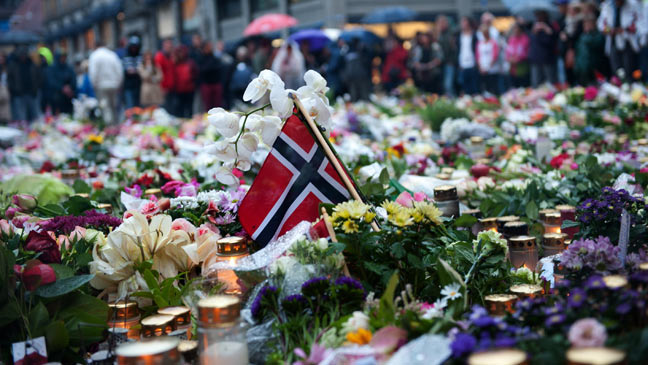
The Famous Trials website includes 90 trials, but none, with the possible exception of the Nuremberg trials, produced more heart-wrenching testimony that the trial of Anders Breivik. The crimes for which Breivik stood trial took 77 lives and left dozens more with permanent and life-altering injuries. But it is who most of those victims were—bright and promising teenagers in one most beautiful, well-managed, and safest countries on the planet—that makes the Breivik trial such a difficult one to write and read about. Why Anders Breivik did what he did that summer’s day on an idyllic island near Oslo needs to be understood—understood so it might never happen again.
The Breivik trial also provides an interesting study in contrasts with the American criminal justice system. Readers more familiar with the adversary system used in criminal cases in the United States will be surprised to read about the Norwegian practice of opening trials with the prosecutor shaking hands with the defendant; or the practice of having guilt or innocence is decided by a group of five judges (two professional judges and three lay judges); or a case in which the defendant is allowed to read (largely without interruption) a lengthy speech explaining the political motivation for his crime; or a case in which the last word in the trial is given not to attorneys, but to a young victim; or a case in which the prosecutor, and not a defense attorney, presents evidence that the defendant is not legally responsible for his actions and should receive treatment instead of a prison term. The trial of Anders Breivik produced a lot of head-scratching among the world’s journalists who covered the trial. You, too, may find yourself shaking yours.
Background
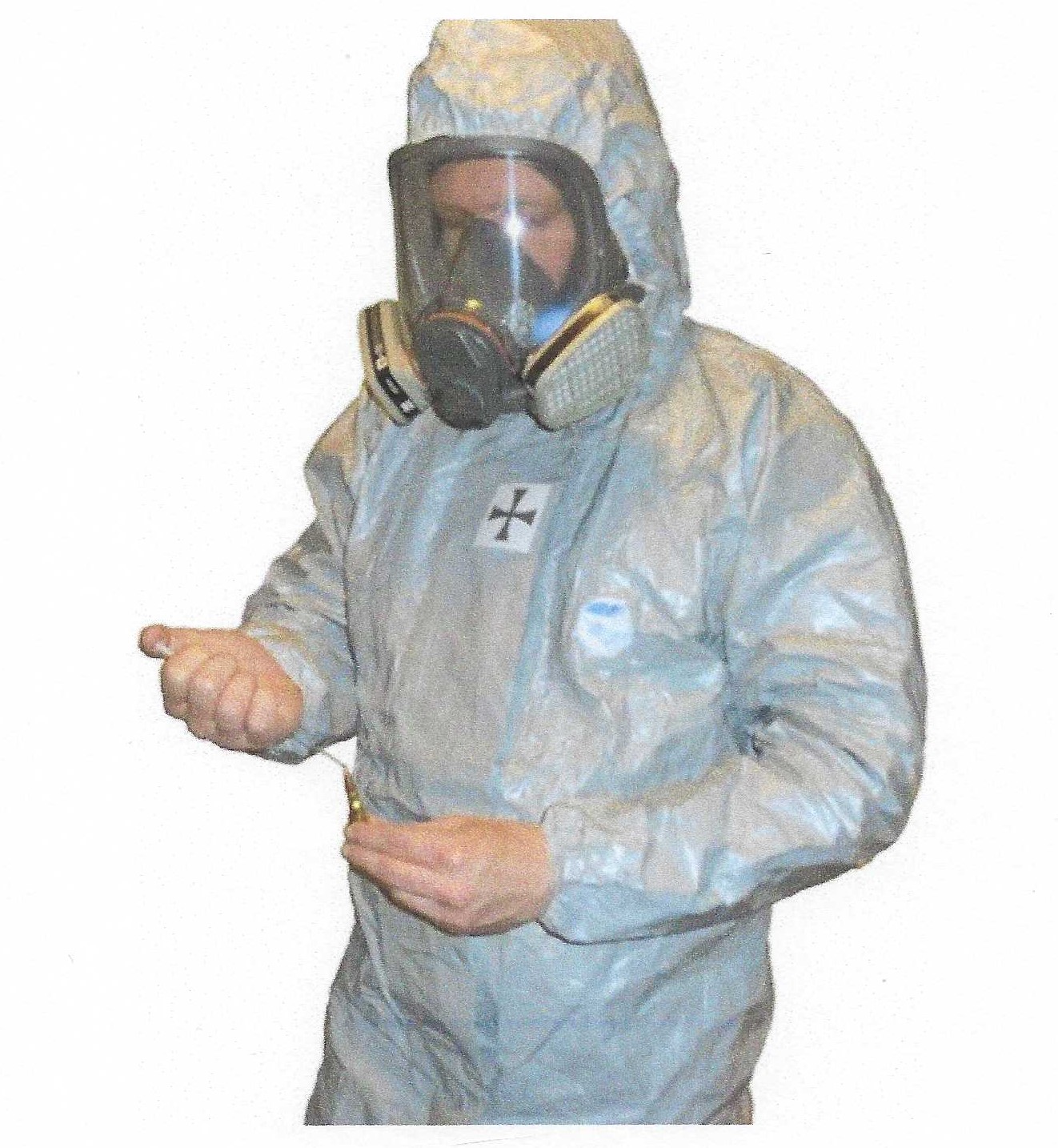
Anders Breivik in the uniform he used to mix hazardous chemicals
By a red barn in forested land along the Glomma River in Norway, in mid-May of 2011, a thirty-two year old man wearing yellow rubber gloves, a respirator mask, and a protective suit, boiled sulfuric acid on a hot plate. His goal was to increase the concentration of 30 liters of acid from 30% to 90%. The man, Anders Behring Breivik, was working to build a powerful explosive that he hoped would shock Norway to its senses. That would be a sort of opening salvo in a war to prevent the destruction of European culture from Islamic immigration.
Nine years earlier, by his own account in his personal log, Breivik concluded, “I have lost faith in the democratic struggle to save Europe from Islamification.” “Armed struggle,” he decided, “was the only way forward.” By 2005, Breivik was working to build a capital base to fund what he called “a martyrdom operation.” By the next year, he had started writing a compendium he called “The European Declaration of Independence 2018” which provided a political justification for terrorism and outlined his own plan to save Europe from the threat of Sharia Law. The work identified categories of “traitors” in Norway who supported multiculturalism, people who would effectively become Breivik’s “enemies list.” The list included everyone from government officials (especially members of the Labor Party) to professors to journalists.
In autumn of 2009, Breivik entered what he called “a phase shift” in his “project.” He began researching how to build high powered explosives, as well as plotting how to acquire the necessary chemicals for construction. He soon realized that building a bomb could not be easily accomplished in Oslo, especially in the home of his mother where he lived at the time. He began looking for isolated farmland within a few hours’ drive of the capital. He also started attending classes at the Oslo Pistol Club and playing the computer game Call of Duty, which he believed sharpened his shooting skills. In February of 2011, submitted his application to purchase a semi-automatic Glock 17.
On April 5, Breivik signed a lease for farmland at Valstua. On the required Norwegian forms, Breivik claimed he would use the farm to raise sugar beets. Four weeks later, in a rented Fiat, Breivik moved out of his mother’s flat in Oslo to the farmhouse along the Glomma River, 87 miles northeast of the capital. He took delivery of six tons of fertilizer. It along with powdered sulfur (from the U.S.), sodium nitrate (from Poland), and aspirin tablets (from many different pharmacies in Oslo), would be the key ingredients for his bomb.
Breivik discovered, as he boiled his acid, that the process produced a thick cloud of smoke that he worried would alarm neighbors and arouse suspicion. He also saw, just as he was about to go outside wearing his full protective gear, a neighbor who had stopped on his property to repair a BMW. He wrote in his journal, “I helped him push out the car and gave him the gasoline required to drive it to his place. I'm going to stick to nighttime boiling from now on to reduce my exposure to any unwanted surprises. I was very lucky today, something I cannot take for granted in the future.”
On June 10, Breivik tried to burn a batch of his explosive in a test run. To what he called “my great disappointment, nothing happened.” The next day he wrote in his log, “I have I prayed for the first time in a very long time today. I explained to God that unless he wanted the Marxist-Islamic alliance and the certain Islamic takeover of Europe to completely annihilate European Christendom within the next hundred years he must ensure that the warriors fighting for the preservation of European Christendom prevail.” The next day, after making an adjustment in the process, he lit a fuse again. Although one strongly doubts God had anything to do with it, this time the detonation was successful. Breivik went out to a restaurant to celebrate.

Utoya Island in Tyrifjord
On July 2, Breivik drove up past Oslo to the Tyrilfjord. He took a steep hill down to a jetty where there was a boat moored. It was called the MS Thorbbjorn, named after a former Labor Party prime minister. The boat was used for transport to a camp on Utoya Island. A week later, Breivik was hard at work on the final stages of his plan, completing the inner charge and mixing chemicals. He noted that he needed “to recharge my batteries and increase my morale” for “the most dreadful task,” so “I bought a lot of exquisite food and candy today.”
On July 21, after loading his explosive materials into a white van, Breivik left his rented farmhouse for the last time. He drove to Oslo and parked the van outside a garden center and then headed to his mother’s flat, arriving shortly before midnight. Tomorrow, he knew, would be the big day.
July 22, 2011
On a rainy morning, Breivik was back at the garden center mounting a fuse to the explosives in his VW Crafter van. He then got back into his nearby parked delivery grey van, a Fiat Doblo, loaded with guns and ammunition, and drove it to a location near the government center. He parked the Doblo and hailed a taxi for a ride back home.
Breivik wrote in his log on July 22 that today “is going to be an all-or-nothing scenario.” He congratulated himself on his lone wolf plan:
The old saying; "if you want something done, then do it yourself" is as relevant now as it was then. More than one "chef" does not mean that you will do tasks twice as fast. In many cases; you could do it all yourself, it will just take a little more time. AND, without taking unacceptable risks. The conclusion is undeniable.
I believe this will be my last entry. It is now Fri July 22nd, 12.51.
Sincere regards,
Andrew Berwick [the pseudonym Breivik uses in his book], Justiciar Knight Commander (Knights Templar Europe).
Breivik hit “send” on his computer screen. And with that action, Breivik hoped to whisk his right-wing compendium, together with an anti-Islamic movie trailer he put together, through cyberspace to 8,000 people on his email list. About 1,000 messages went out before a spam filter kicked in to stop the process.
Breivik left the flat, hiked down to the garden center, climbed into the van. He changed his clothes his the van. He put on a black compression top and attached a police insignia to its sleeve. Then he pulled on a bulletproof vest and black boots. He drove off. He parked the van, with its 950-kilo bomb outside the Tower Block in the government quarter. The Prime Minister’s office occupied the top floor of the building. He hoped the bomb would bring the whole building down. From the front seat, Breivik lit the bomb, then exited the van and headed off quickly in the direction of his parked Doblo.
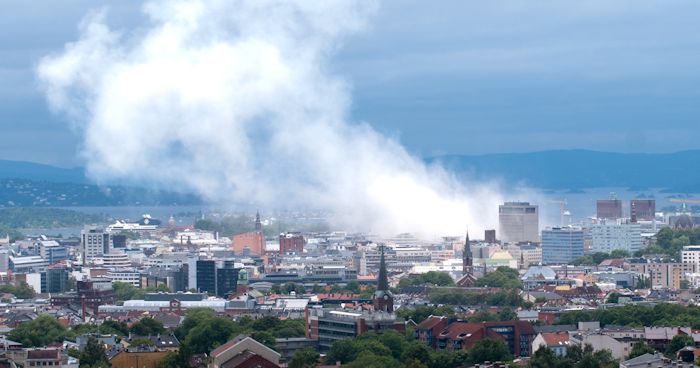
At 3:25 pm, the van exploded. Eight people lay dead or dying. Many others were seriously injured. The Prime Minister, who chose to work that day from his private residence, was not among them.
Acting on a tip from someone who saw Breivik rushing back towards his getaway vehicle, Oslo police issue a bulletin at 4:02 pm ralerting all units to be on the lookout for a European, about thirty years of age, driving a Fiat Doblo with license number VH 24605. Meanwhile, the van bearing that license was headed for Utoya Island.
This was the time of “what ifs.” In the critical police district, policemen in a patrol car that was ordered to go out on observation along the E18 (the highway Breivik was then driving) ignored the order and instead drove to Oslo to transfer a prisoner to, as they later said, “get the job over with.” Norway owned only one police helicopter, but in a money-saving measure, the emergency crew was given the month of July off. A pilot who nonetheless reported for duty after the bombing, was told his services were not needed. Because no nationwide emergency alert was sent out, no roadblocks were set up around Oslo.
A boat for Utoya Island was scheduled to leave the jetty along the Tyrifjord at 5:00. Breivik parked above the jetty and fortified himself with a Red Bull. When the boat didn’t arrive as schedule, Breivik, wearing his police uniform, went down to the jetty to talk to a young AUF security guard. When the guard told him the boat had been “cancelled because of the explosion,” Breivik told him to call the boat over. The guard did as asked.
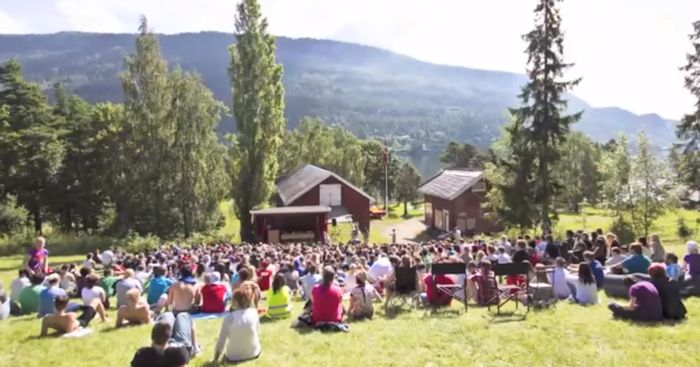
Worker's Youth Camp at Utoya during a happier time
Breivik boarded the MS Thorbjorn. After a few minutes crossing, the boat docked at Utoya. It was 5:15. A police guard on the island, Trond Bernstein, greeted Breivik and led him up a grassy slope.
“It was now or never,” Breivik thought. He pulled out his Glock and fired a bullet into his head. Trond Bernstein was the first of 69 to die on Utoya on July 22, 2011.
Some campers tried to flee into woods. Some played dead. Some dove into the water and began to swim. Breivik killed three people by the boat landing, then three by the boat landing, two more on the way to the main camp site, one at the campsite. Then he entered the building that housed the café and main hall. Over the next two minutes, he methodically executed thirteen young people, mostly with shots to the head. Breivik encountered eleven campers playing dead along a trail called Lovers’ Path. He killed them all. He found others trying to escape down a steep cliff towards the water. Breivik shouted, “I will kill you all, Marxists!” and began firing. And the killing continued.
At 5:42, almost a half hour after Breivik’s arrival on the island a task force of twenty-six men headed out from Oslo towards Utoya in heavy black vehicles with flashing blue lights. By 5:52 the first local police officers reached the jetty. They could hear the shooting on the island. They were told to wait for a police boat. Wait they did. A nearby fire service officer had called earlier to offer their boat, already to move, but the police station turned down the offer. They said they had their own boat. But the police boat needed to be inflated, and then filled with gasoline—and all that took time, precious time.
At 6:01, after killing at least forty people, Breivik called the emergency number on a cell phone. “My name is Commander Anders Behring Breivik of the Norwegian Anti-communist Resistance Movement,” he said. “I’m on Utoya at the moment. I’d like to give myself up.” While waiting for police to arrive, Breivik continued to hunt down campers and shoot them.
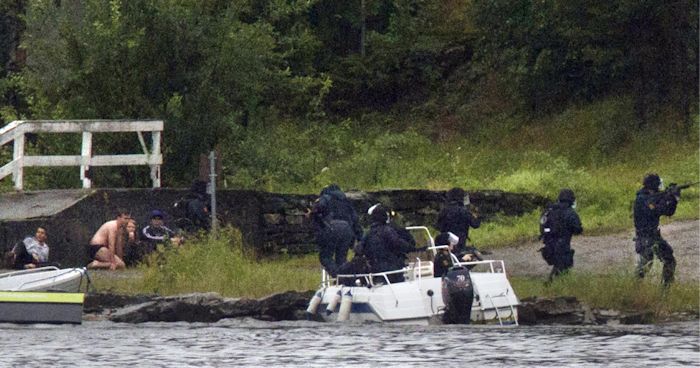
Police arriving on Utoya
Meanwhile, ten heavily armed officers set off in a dinghy for Utoya. Only a few hundred yards out into the fjord, the engine sputtered and died. Things were not going well. A private boat owner came to the officer’s rescue. The officers scrambled into his boat, and he moved over to the dinghy. While the officers finally on their way, the private boat owner rowed the dinghy back to shore. The first boat carrying police arrived on Utoya at 6:27, well over an hour after the shootings began.
The police found Breivik by a red building called the schoolhouse. “Armed police! Stand Still! Hands up!” Breivik put his rifle against a tree and began walking toward the police. It was over. “This is the start of hell,” Breivik told the officers. “It’s going to get worse” when the “third cell is activated.”
The Investigation
The first police interview with Breivik took place on the island. Breivik told police he was “a commander of the Knights Templar” and the goal of the Knight was “to take power in Europe in sixty years.” He added, “I’ve written a 1500-page manifesto on this.” He offered no apologies for his crime. “It’s the Labor Party, the youth wing. They’re the ones who have presided over the Islamisation of Norway.” He told his interviewers that he took no pleasure in what he had done. He described the events of the day as “tragic” and “bloody awful.” But he did it, he said, “to save Norway.”
During a break in the interview, police ordered Breivik to strip. His clothes would be saved as evidence. Down to his underpants, Breivik started posing for the police cameraman. He tried out classic bodybuilding poses and laughed. Breivik, it seemed, was a very strange dude.
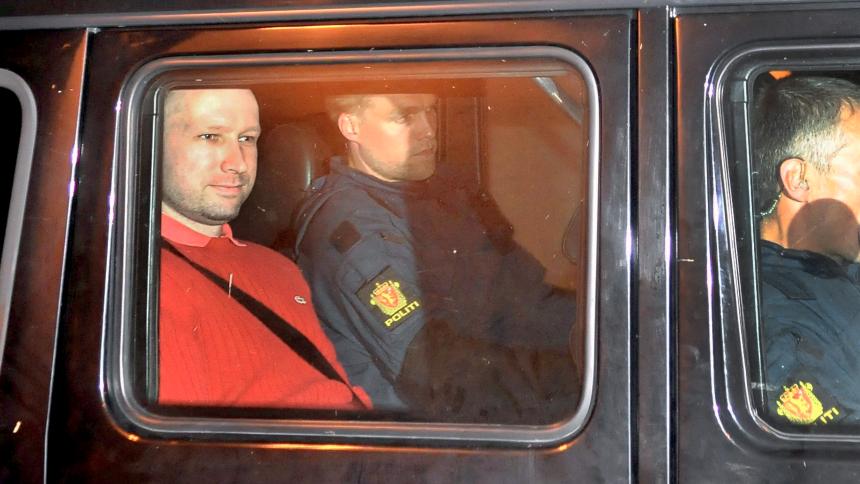
Breivik in a police car
The next day, in Oslo police headquarters, Breivik refused to be interviewed further until he was given defense counsel. He asked for a lawyer he knew, a lawyer who was defending a neo-Nazi accused of murder: Geir Lippestad. After Lippestad showed up, and authorities agreed to a list of his demands (relating to access to a computer and conditions of confinement), the interrogation resumed. He told police of his reluctance to undertake the Utoya operation. “If I had a choice, I would have skipped Utoya, it’s too dirty,” he said. “It must be absolutely awful being a parent who’s lost a child.” But then he turned in his thoughts; he blamed the parents for shirking “their responsibility to make sure their child didn’t turn into an extreme Marxist working for multiculturism.”
At a remembrance service on Sunday, Prime Minister Jens Stoltenberg spoke for many Norwegians when he said: “We are shaken by what has happened, but we will never relinquish our values. Our answer is more democracy, more openness, and more humanity. But never naivety.” The next day, over one million Norwegians turned out to show support for the victims and the values of Norway. Many carried roses.
In August, the first of many psychiatrists met with Breivik. Synne Sorheim and Torgeir Husby met thirteen times with the terrorist. The two psychiatrists concluded Breivik was a paranoid schizophrenic. If the court were to accept their conclusion after trial, Breivik would be given treatment rather than a prison sentence. Breivik was not happy. He told his lawyers he wanted to be found responsible for his actions, not made to look a fool.
Breivik was not alone in this desire. Families of the victims and public advocates wanted to see Breivik locked away in a prison as long as possible, not sent to a hospital. They got their way; the court appointed two additional forensic psychiatrists, Terje Torrissen and Agnar Aspaas, to draw their own conclusions as to Breivik’s mental health. They came to a conclusion very different than the first team of psychiatrist. Torrissen and Aspaas said Breivik suffered from a dissocial personality disorder and had narcissistic traits, but that he did met the standard for bearing accountability for his actions.
The Trial
The trial opened in room 250 on the first floor of the Law Courts. Behind the defense bench was a bullet-proof glass wall separating the trial participants from family members of victims, journalists, and other spectators. At about ten minutes to nine, two guards led Breivik into the main trial room. He smiled for photographers and, after having his handcuffs removed, thrust is arm straight out and gave a closed-fist extremist salute. Then, after this defiant display, the public prosecutors walked over to shake his hands. They were followed by lawyers representing the victims’ defense and the public advocates. They do things differently in Norway.
At nine o’clock, everyone (at least, everyone except Breivik) rose as the five judges, including two appointed judges and three randomly selected lay judges, took their seats at the dais at the front of the room. One lay judge was a pregnant school teacher of Columbian ancestry. Another was a consultant in the Department of Education, and the third a retired family counselor. The head judge, Wenche Elizabeth Arntzen, rapped her gavel and announced, “The court is in session!” At that, Breivik said, “I do not recognize the Norwegian court or law because your mandate has come from parties that support multiculturalism.” Arntzen asked Breivik whether he wished to lodge a formal objection to her participation on the grounds of bias. When Breivik replied that he was just trying to make a point, the trial continued.
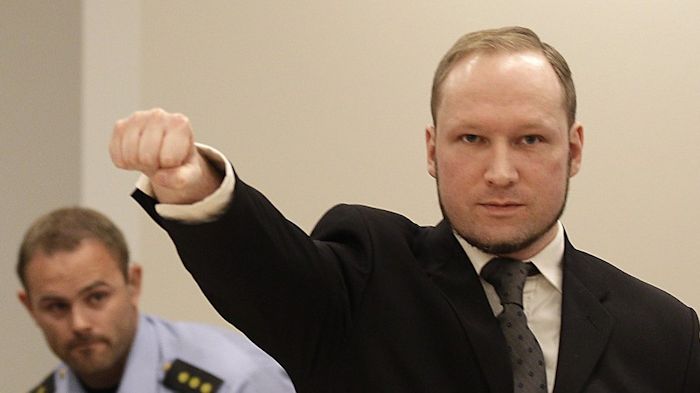
Breivik defiantly saluting in court
The charges against Breivik were read by public prosecutor Inga Engh. Engh said that Breivik stood accused of violating the terrorism provisions of Section 147a of the Norwegian Penal Code, "destabilizing or destroying basic functions of society" and "creating serious fear in the population."
Engh said the prosecutors recommended a finding that Breivik’s mental condition was such that he “should be transferred for mandatory psychiatric care . . . for committing while in a psychiatric state an act otherwise punishable by law.” In other words, the prosecution accepted the findings of those psychiatrists that Breivik was sufficiently sick that he was not legally responsible for his actions. Engh, with moving specificity, listed the circumstances under which Breivik took each of 77 lives. She was at the entrance to the Tower Block [in the government quarter] near the van and died instantly of massive injuries caused by the pressure wave and the impacts of splinters and objects. He was at the campsite. She was on the shoreline on the southern tip. She was on the Lovers’ Path. For most of the young victims on the island, the cause of death was usually the same. He was shot in the back of the head. She was shot in the back of the head. As the reading of the charges continued, Breivik kept his head down and played with his pen.
When, after more than an hour, the prosecutor finished, the accused entered his plea. Breivik rose and said, “I admit the actions, but do not admit guilt, and plead the principle of necessity.” That is, Breivik contended that the killings were a necessary evil to prevent an even greater negative consequence, a more multi-cultural Norway.
The core legal question the criminal trial needed to answer was what happened on July 22 the act of a madman or a political terrorist? Or, put another way, should Breivik receive medical treatment or a prison term? While it was, of course, theoretically possible that the judges could buy Breivik’s argument that the killings were an act of self-defense or moral necessity, no one—including Breivik himself—expected that to happen.
Co-prosecutor, Svein Holden, in his opening statement argued, traced Breivik’s descent into delusional right-wing fanaticism. Holden argued that Breivik’s mental health declined markedly in 2006, after he moved back into his mother’s home and begin almost non-stop playing of the video game World of Warcraft (Breivik’s game name was Justiciar Andersnordic). A year or two later, he began writing a political manifesto suggesting the need of a civil war to protect Norway from Marxism, Islamism, and multi-culturalism. He described how to make bombs—and the bomb he exploded on July 22 was made exactly according to the book’s recipe. He identified himself as the commander of the Knights Templar, an organization which turned out to exist only in the mind of Breivik. (An important question, going to the degree of Breivik’s sanity, was whether he actually believed the Knights Templar existed, or whether he just thought claiming the title of commander in a romantic-sounding outfit might enhance his standing in the world of right-wing politics. The latter is more likely the case.)
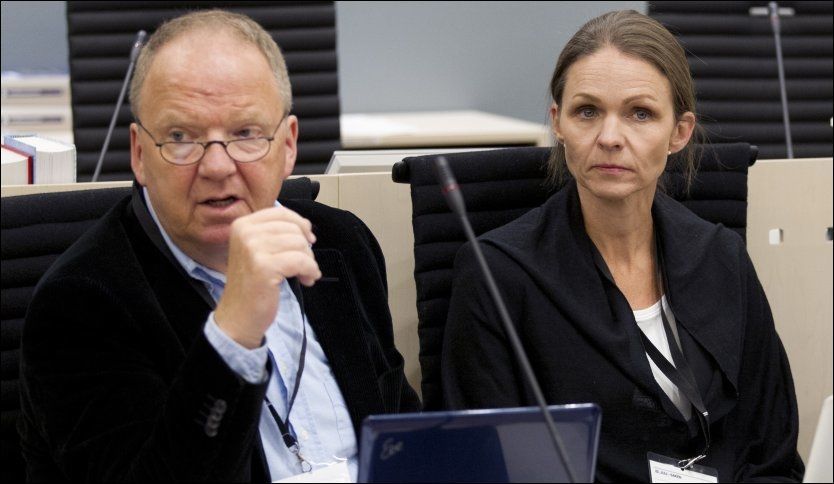
Psychiatrists Sorheim and Husby testifying at trial
Holden told the judges, “He also made a film.” He played the Movie Maker video that consisted of 99 images cut together. Judges, lawyers, and spectators watched Breivik’s production, showing veiled, pregnant women with hand grenades, masses of refugees making their way to Europe, Soviet soldiers waving the Soviet flag. Then the tone of the movie changed. Accompanied by music from the video game Age of Conan, Breivik’s logo for the Knights Templar appeared on screen along with words like honor, strength, and martyrdom. The film ended with the sentence: “Islam will again be banished from Europe!” If no one else found the film moving, at least Breivik did. He wept openly as the images revealed themselves, one after another, on the room’s screen.
A more emotional moment for most people followed. Holden played an audio tape of an emergency called made by a girl from Utoya ten minutes after Breivik arrived on the island. She was calling from a bathroom stall. “Hi, there’s shooting on Utoya in Buskerud in the Tyyrifjord,” she said, breathing heavily. “There’s total panic. He’s in here!” she whispered. Then there is a scream. Then several more screams. The sounds of gunfire are heard, with shots fired in rapid succession, fifty in all over the course of three minutes. The audio tape was powerful; many in the courtroom were left sobbing.
The second day of the trial featured a monologue by Andre Breivik, laying out his “necessity defense.” Relatives of the victims were in no mood to hear it; when the defendant began to speak, they walked out of the courtroom. Breivik clearly relished the opportunity, seeing it both as a chance to promote his book, the Breivik Diaries, and to gain fame and influence followers in his far-right world of politics. “I stand here today as a representative of the Norwegian and European resistance movement,” he began. He denounced the media for portraying him as a pathetic loser. “I knew the cultural elite would ridicule me,” he said. Then he boasted of what he had done. “I have carried out the most sophisticated and spectacular attack in Europe since World War II. I and my nationalist brothers and sisters represent all that they fear. They want to scare off others from doing the same thing.”
Breivik railed against modern trends that “have brought us feminism, gender quotas, the sexual revolution, a transformed church, destruction of social norms and a socialist, egalitarian ideal of society.” He said Norway now suffered “from cultural self-contempt as a result of multicultural ideology.” Breivik recognized that what he did was brutal, but then added, “Brutality can have good intentions.” If killing more than seventy people changed the direction of Norway, it was all worth it, he claimed. “It will help to prevent a civil war that could result in the deaths of hundreds of thousands of Norwegians. It is better to commit a minor barbarity than a major barbarity.”
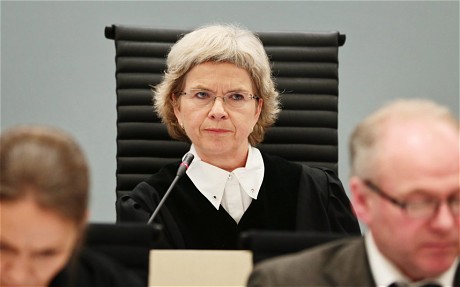
Judge Arntzen looking skeptical during trial
Breivik complained that “cultures like Islam” were “spreading like cancer” leaving ethnic Norwegians to “sit with our sushi and flatscreen TVs,” but bereft of the culture that had made Norway great. He warned that sharia law might find a place in his country and then Norway will spend all of its oil money on immigrants. Judge Arntzen broke in to ask Breivik to “show consideration” for the feelings of bereaved relatives of the victims, watching the proceedings on live television all around Norway. Breivik said that he would.
“Oslo is a city in ruins,” Breivik declared. Muslims are now demanding “special dispensations” and soon will be demanding self-rule. Indigenous people, he said, who fight outsiders are not wicked, but heroic. He compared his fight to the fights Sitting Bull and Crazy Horse waged against those that came into their native land. He said calling nationalists “terrorists” was not only wrong, it was “racist.”
Breivik finished his oration by saying his actions represented “the first drops of water heralding the coming storm. Rivers of blood will run through the cities of Europe.” In the end, he predicted, “My brothers and sisters will win.” It is important now, he said, “for more patriots to shoulder their responsibility, as I have done. Europe needs more heroes!” Breivik took a breath. “I acted on the principle of necessity on behalf of my people, my religion, my city and my county. I therefore demand to be acquitted of these charges.”
In the next stage of the trial, the two public prosecutors, Engh and Holden, presented evidence concerning the murders of each and every one of the 77 murders committed on July 22. No one was to be forgotten. Sensitive to the wishes of most relatives of victims, the prosecutors chose to kept photographs of victims, often with shattered skulls and smeared brains, in folders that would be given only to members of the court, rather than shown on the courtroom screen. Instead, they chose to order a dummy that could be used to represent each victim. The dummy was ordered in neutral grey, so as not to offend family members of non-white victims. A pointer was used to indicate bullet entrances.
For each victim, a forensic technician explained the circumstances of each death—what injuries were inflicted, and where the death occurred. And for each victim, public advocate Nadia Hall delivered a brief eulogy. She told of each victim’s hopes and dreams, as well as the loved ones they left behind. Breivik, according to trial reports, kept his head down during most of the autopsies and eulogies, either looking at papers or shuffling them.
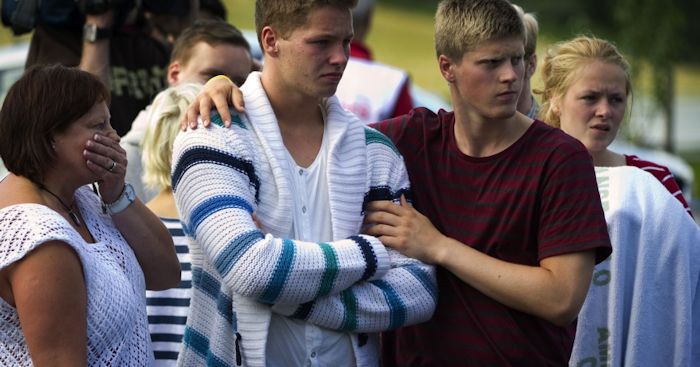
Survivors of the shootings on Utoya
A week for the victims over, the trial focus turned to the survivors. One after another, young people on Utoya who lived through the attack came forward to offer testimony. Each described the nightmare in their own way. “I was swimming ahead of him. He dropped behind. Then I turned around and he wasn’t there any more.” Or “I thought it must be my turn next.” Or “I lost my best friend.” Tarjei Bech likened Breivik to the villain of Harry Potter novels, Voldemort. He told of hearing him "breathing and hissing" as he approached him and began shooting. Frida Skoglund told of fleeing into the woods and then, after a bullet penetrated her thigh, swimming toward safety with others--three of whom didn't make it. Still, Skoglund said, "We won, he lost!"
In her book “One of Us,” Asne Seierstad recounts the testimony of a boy named Viljar, from the far north island of Svalbard. Viljar was hit by a bullet that tore through his eye and smashed his skull. His best friend and his younger brother were shot and killed. For six days, Viljar in lay in a coma, his body growing cold, his heartbeat laboring, teetering on the edge of death. On the sixth night, Viljar started singing, then fell back into unconsciousness. But he made it. He remained in the hospital for three months, and underwent numerous operations. Viljar appeared in court, with his glass eye and prosthetic hand, dressed in a black shirt and black trousers. Inga Engh asked Viljar, “Can you start by telling us what happened to you on Utoya?”
Viljar said that when he heard shots, he and his brother started running. “We ran across Lovers’ Path. My little brother and I made our way down a sort of slope, cliff-edge thing. The bangs were getting nearer, and in the end, they were really, really close.” Viljar described what he saw and felt after he was shot. “It was very strange being shot, it didn’t hurt—it was just unpleasant. . .I looked at my fingers and saw they were hanging on only by scraps of skin. I realized I couldn’t see out of one eye and that something must be wrong there. I started running my hand over my head and eventually came across something soft and then I touched my brain. I was feeling my own brain.” Engh asked Viljar how he was doing now. “Quite a challenge, all the anxiety and nerves. I only feel safe in a moving car. . .I still seem to find things difficult.” Before the shooting, Viljar played soccer, drove snowmobiles, and skied. Now, there could be none of that. He was learning to hold a pen, to tie his shoelaces. Judge Arntzen excused Viljar when he had nothing left to say. “Fabulous,” he said, as he turned to leave the courtroom.
When the defense had its turn to present evidence, various philosophers and historians and other experts in the fields or extremism and terrorism testified that Breivik’s views were not a singular or idiosyncratic set of ideas, but were rather views shared by many other people. Breivik’s views might not be popular among Norway’s elite or mainstream population, but neither were they bizarre or delusional.
Next came the psychiatric phase of the trial. A dozen psychiatrists paraded into court to offer their views as to Breivik’s mental state and moral responsibility for his actions. The views were all over the lot. Psychiatrist Frederick Malt saw Breivik not as a “monster,” but rather as “deeply lonely man” who lived “inside his shell.” He might be “a right-wing extremist bastard,” but Malt said he was “also a fellow human being who is suffering.” Malt said Breivik “struggles to understand social signals” and, in his opinion, suffered from “autism, or Asperger’s syndrome.” He called Breivik’s actions “mechanical killing,” and noted that he went “ashore on an island and shot young people and talked about it as if he had been picking cherries.”
Malt’s diagnosis incensed Breivik. He called Malt’s testimony “character assassination” that was almost “comical” in its inaccuracy. Breivik declared, “I have never been lonely.” Nor, he said, was he incapable of friendship or prone to depression. He added, “The impression had been given that I hate women, but I love women. I hate feminism.” As for Malt’s suggestion that Breivik had a narcissistic personality, Breivik said if he was narcissistic, then “half of Oslo would fall into that category.” He ended his response by returning to his main theme: this should be a “case about political extremism and not psychiatry.”
Psychiatrist Eirik Johannessen, who spent as much time interviewing Breivik as anyone, testified that he saw no signs of psychosis in the defendant. Where some psychiatrists saw in Breivik’s repeated references to the Knights Templar a sign of delusional thinking, Johannessen saw it simply as a convenient lie that helped “recruit people to his network” and “generate fear” in his opponents. It also, he said, made “himself appear a more exciting person.” In Johannessen’s thinking, it was personal failure that “pushed him to extremism.”
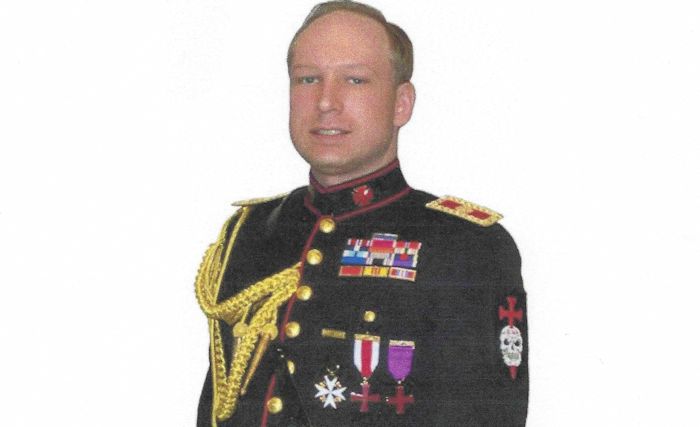
Breivik dressed in his "Knight Templar" uniform
Again angered by the psychiatric testimony, Breivik claimed not to be a failure. “I have never been rejected by anyone in my whole life,” he said.
The psychiatric team of Sorheim and Husby testified that they stood by their original report from November 2011 that Breivik was delusional and thus not legally accountable for his actions. Judge Arntzen appeared skeptical, asking Sorheim if he found Breivik delusional simply because his actions were “so immoral.” Sorheim replied that there conclusion was based not so much on Breivik’s actions as on the fact that “he devoted years to finding out who would have to die.”
The psychiatric team of Aspaas and Terje Torrissen reached an opposite conclusion. They testified that Breivik did not fit well into “prevailing classification systems.” They agreed that he displayed narcissistic traits, but not the sort of personality disorder that might make him unaccountable for his actions.
The last day of trial was set aside for impact statements by aggrieved parties. Mothers spoke about losing children; government employees spoke about losing colleagues. It fell to a seventeen-year-old girl from Iraq named Lara to make the closing statement of the trial. Lara spoke of fleeing Iraq in 1999 with her older sister, Bano. They told each other everything. Bano, she said, at one time assured her, “Even if you happen to lose friends, you’ll never lose me.” Bano died on Utoya. Lara said, “It should have been me that died.” Breivik, she said, “didn’t only take away my security, he took away the safest person in my life.” But, she added, “Bano didn’t die for nothing. She died for a multicultural Norway… I’m proud of her.”
On August 24, 2012, the court announced its verdict. Judge Arntzen stood and read the decision: “Anders Behring Breivik, born 13 February 1979, is convicted of breaching Section 147a of the legal code.” Breivik smiled. The verdict meant that he was not a madman; he was the political terrorist that he wanted to be.
Breivik received the maximum punishment of 21 years in custody. The sentence could be extended for five years if, at the end of that period, he still was found to be a threat to society. And potentially five years after that, and again until he died.
Epilogue & Lessons
Breivik chose not to appeal his conviction. The reason, he said, was that appealing the decision of theOslo District Court would be tacit recognition of the court’s legitimacy, which he denied.
First imprisoned at Ila Prison, Breivik was transferred to Telemark Prison’s Skien Department, about 62 miles southwest of Oslo, in 2013. He remains there at this writing. He lives in isolation, in a high-security section of the prison, with his only usual contact with guards and health care workers.
The strict routine and controls have not made Breivik a happy inmate. He objected to his prison conditions on a 27-page letter to prison authorities. He complained about the temperature, cold coffee, a rubber pen that gave him hand cramps, plastic cutlery, the handcuffs he had to wear when he was led to the exercise yard, the constant surveillance, the poor view from his window, insufficient slices of bread, the failure to upgrade his game console from PlayStation 2 to PlayStation 3, the quality of the picture on his television set, his furniture, strip searches, and the lack of ability to choose the art for his cell walls.
In 2016, Breivik sued the government, alleging that the solitary confinement and other conditions of his imprisonment violated his civil rights. Although Breivik scored a partial victory in trial court, the Norwegian Supreme Court found that the solitary confinement and prison conditions did not violated his rights. In 2018, Breivik filed a complaint with the European Court of Human Rights, which dismissed his case. While in the process of pressing his claims, Breivik also legally changed his name. He is now Fjotolf Hansen.
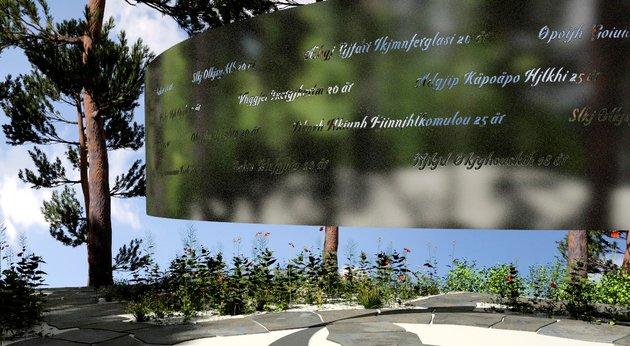
In the summer of 2015, a monument to the victims was dedicated on Utoya. The monument consists of a ring of steel hanging between trees. The names and ages of each of the 69 victims at Utoya are engraved on the ring. Also that summer, Norway opened the 22 July Centre in Oslo at the location of the 2011 bombing. The centre hosts documents, images, artifacts, and exhibits. The effect of the bomb blast can still be seen on both the inside and outside of the building.
The suffering caused by Breivik on July 22 goes on. As Asne Seierstad notes, “grief is a solitary journey.” In some ways, the pain of the victims is all the greater because of their knowledge that the tragedy could have been avoided. Norway’s 22 July Commission published a report highly critical of the nation’s preparedness for a terrorist attack and its specific response to the Oslo bombing and shootings on Utoya. It’s clear the system failed. The report contained numerous suggestions for security improvements.
There is another lesson. Anders Breivik was not a member of a terrorist cell. He was not someone with a prior diagnosed mental illness. He was neither a sadist nor a person someone might call “a monster.” These facts are troubling, it suggests the vulnerability of nations to a lone wolf terrorist whose schemes are not easily detected or predicted.
Yes, Breivik possessed the qualities that have been associated with great evil. He had a strong—even fanatical—belief in an ideology that defined groups of people as the enemy. He lacked empathy or an easy ability to put himself in another’s shoes. But lots of people share those qualities and very few shoot young person after young person at close range.
Breivik had a need “to be somebody.” In his essay, “The inexplicable: Inside the Mind of a Mass Killer,” Karl Ove Knausgaard put it this way: “He wanted to be seen; that is what drove him, nothing else. Look at me. Look at me. Look at me.” As Knausgaard sees it, Breivik, in the isolation of his room and his constant playing of computer war games, found new and uncomplicated models of reality and “decided to bring them to life.” He shed his old psyche for a new one, “desensitized and ruthless, a soldier’s identity” and “reshaped the outer world in his own image.” In Knausgaard’s words, Breivik converted the bodies of the young people he hunted and shot into “images, pixels, and digits.” And the result was a tragedy like no other, experienced by the entire population of Norway, from top to bottom.
Parole Denied
On February 1, 2022, a Norwegian court ruled that Breivik must remain in prison as he still posed "an obvious risk" to society. A month earlier, at a parole hearing, Breivik flashed Nazi salutes on the opening day and professed white supremacist views. He did did, however, renounce violence. Prosecutor Hulda Karlsdottir argued that Breivik had "not shown any genuine remorse" for his actions in 2011.
